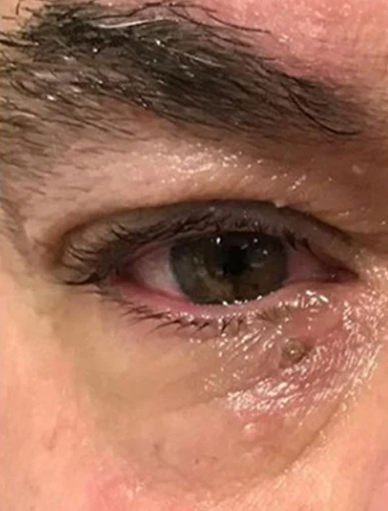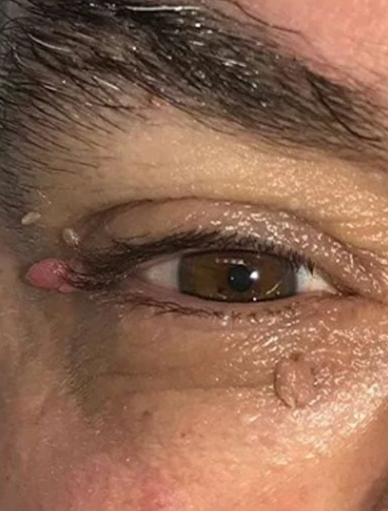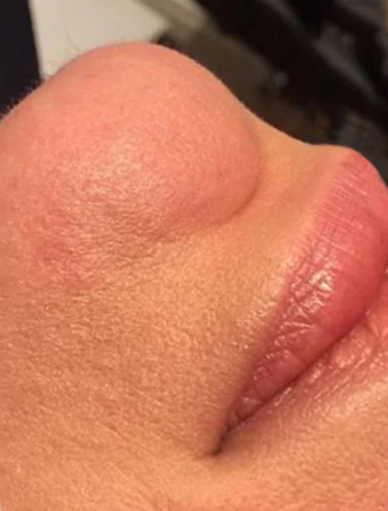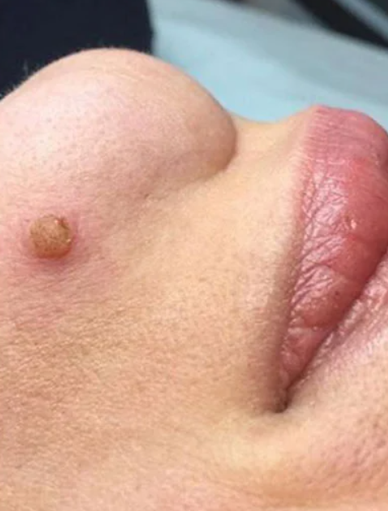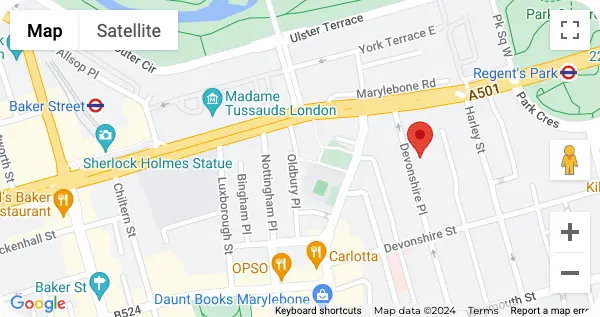Introduction
We know that skin lesions such as harmless moles, skin tags and other blemishes can not only be a cosmetic concern – they can also be painful hindering you day to day. Cryotherapy offers a fast, low-risk method increasingly used in aesthetic medicine to safely target unwanted skin lesions, all with minimal downtime.
This article will cover all you need to know about cryotherapy for mole removal including how it works and what to expect before, during and after treatment.
What Is Cryotherapy?
Cryotherapy is a medical procedure in which a part of the body is exposed to subzero temperatures to destroy a diseased or abnormal tissue. In dermatology, this is typically accomplished by freezing cells quickly with liquid nitrogen, which reaches temperatures as low as –196°C.
The goal is that controlled cell death (cytolysis) in the treated area will lead to the skin repairing and regrowing itself. “Cryotherapy” can be an umbrella term for whole-body treatments for the likes of inflammation and recovery but, in skin clinics at least, it most often translates to a specific, targeted procedure known as “cryosurgery.”
Common Uses in Dermatology
Cryotherapy is frequently used to treat:
- Benign moles and skin tags
- Seborrhoeic keratoses
- Actinic keratoses (precancerous sun spots)
- Viral warts
- Milia
- Solar lentigines (age spots)
- Molluscum contagiosum
Due to its non-invasive nature, it’s often preferred for facial or highly visible areas where preserving cosmetic outcomes is essential.
How Cryotherapy Works for Mole Removal
With cryotherapy, a freezing substance is used to freeze the lesion either by applying it directly to the lesion or by spraying the cold agent onto the affected area using a device known as a cryoprobe or cotton swab. The rapid freezing process forms ice crystals within the targeted cells, disrupting the cell membranes and leading to controlled cell destruction.
Cryosurgery for Moles Explained
In cryosurgery, the clinician carefully controls the depth and duration of the freeze to ensure complete destruction of the mole while preserving the surrounding healthy tissue.Depending on the size and nature of the mole, the freezing takes about 10-30 seconds for each application, and a freeze-thaw-freeze regimen is more effective than a single process.
Following the treatment, the mole undergoes a process of blistering, crusting, and ultimately falling off, usually within 1 to 2 weeks.
Benefits of Cryotherapy for Skin Tags and Moles
Cryotherapy is now the treatment of choice for individuals requesting a simple, low-risk method for removing benign pigmented skin lesions. Its benefits are plenty, particularly for patients who want results without surgery.
Minimally Invasive Treatment
Cryotherapy does not involve cutting, suturing or much preparation. It’s a walk-in, walk-out procedure that is completed in minutes. In most cases, no anaesthesia is required and the process is well tolerated even on sensitive areas of the body such as the face or neck.
Quick Recovery Time
The majority of patients can resume their routine activities following the treatment. There might be some temporary redness, swelling, or light blistering, but such responses usually clear up on their own. Complete epithelialization usually occurs between one and three weeks, depending on the location and depth of the treated lesion.
Reduced Risk of Scarring
Because cryotherapy doesn’t require any incisions or excisions the potential for permanent scarring is relatively low. When performed by experienced practitioners, cryotherapy yields clean cosmetic outcomes, particularly when treating raised skin tags or superficial moles.
Cryotherapy Mole Removal Stages
Understanding what to expect at each stage of cryotherapy can help you feel more confident and informed before proceeding with treatment.
Consultation and Assessment
All treatments start with a thorough consultation. Here at Harley Street Skin Clinic, we evaluate:
- Type of lesion
- Your type of skin and your medical background
- Your goals and expectations
The mole will be directly visualized and also potentially dermatoscopic evaluated prior to treatment for it to be determined as non-melanoma mole. If malignant cells are suspected, then further investigation or biopsy may be indicated.
Treatment Procedure
On the day of your appointment:
- The skin is cleansed.
- A cryoprobe or a cotton applicator is employed to place liquid nitrogen directly to the mole.
- This is repeated with a 10-30 second freeze-thaw interval dependent on mole depth.
- The procedure can be repeated for deeper penetration or bigger lesions.
Patients describe tingling or stinging feelings during treatment that are replaced by numbness or slight soreness.
Aftercare and Recovery
Post-treatment, the area may:
- Redden or swell slightly
- Form a blister or scab
- Darken before flaking off
You’ll be advised to:
- Keep the area clean and dry
- Do not pick or rub the site
- Put an antiseptic cream on it if you need to
- Use SPF 30+ on exposed areas
Most patients see final results within two to three weeks, though deeper lesions may take slightly longer to resolve completely.
Effective & professional doctor-led Cryotherapy Mole Removal at our central London clinic
Verified Before & After
Verified Before & After
Cryotherapy Clinic: What to Look For
Not every clinic provides the same standard of care. When selecting a cryotherapy provider, here is what you should look for:
- Credentials and Expertise
Ensure the procedure is carried out by a medically qualified professional with training in dermatological or aesthetic treatments. At Harley Street Skin Clinic, all procedures are performed by highly trained clinicians using industry-leading equipment.
- Equipment and Techniques
It is recommended that cryotherapy be applied with quality medical equipment and the control of freezing time and strength. Accuracy is essential to limit injury to the surrounding tissues.
- Patient Reviews and Testimonials
Search for real-world reviews, before-and-after photos, and customer testimonials. A trustworthy clinic consistently produced good results and satisfied customers.
Cryotherapy Mole Removal Before and After: Real Results
Many patients report increased confidence following the removal of longstanding moles or skin tags, particularly when located in prominent or visible areas. While there is variation among individual results, there are some overall patterns:
- Raised moles flatten and disappear within 7–14 days
- Skin tags dry out and fall off with little to no trace
- Pigmentation fades gradually as the skin regenerates
Photos and Case Studies
We keep the actual results of real patients in-clinic. Out of respect, they can be seen during consultation on full consent of previous patients. These case studies serve to create an appropriate level of expectation for your treatment.
Can Cryotherapy Remove Moles?
Assuming the mole is not cancerous, yes. Cryotherapy can be an efficient and safe way to get rid of:
- Compound and dermal naevi (raised moles)
- Seborrhoeic keratoses (waxy or rough growths)
- Fibroepithelial polyps (skin tags)
It is not suitable for:
- Suspicious, irregular, or bleeding moles
- Deeply rooted congenital moles
- Flat pigmented moles in some darker skin tones (due to hypopigmentation risk)
Suitable Candidates for Treatment
You might be a good candidate for Cryotherapy if you:
- A medically qualified clinician confirms that the mole is benign
- You want to treat it fast and reduce any scars
- You prefer a non-surgical solution
- You don’t tend to keloid scar
Cryotherapy is safe in most adults of all ages and skin types, although your provider may adjust the method if you have specific circumstances.
What to Expect During the Procedure
- Quick application (5–10 minutes)
- Slight discomfort, often described as a sting
- Mild swelling or blistering afterward
- Full healing within 1–3 weeks
Frequently Asked Questions
Is Cryotherapy Safe?
Yes. Cryotherapy is regarded as low-risk when done by qualified professionals. The side effects are typically mild and temporary.
- Mild blistering
- Temporary redness or swelling
- Lightening or darkening of skin (usually fades)
Complications, like infection and scarring, are rare, especially if you take good care of it afterwards.
How Many Treatments Will I Need?
The majority of patients flow through a single session per lesion. However, bigger or thicker moles may also require a second treatment a few weeks later. At the time of the follow-up, your clinician will review the area and decide whether further treatment or cryotherapy is necessary.
Cost of Cryotherapy for Mole Removal
At Harley Street Skin Clinic, pricing varies based on:
- Size and number of lesions
- Location on the body
- Complexity of treatment
Average costs are £95–£250 per session. And then we quote you individually after discussion.
Final Thoughts
Cryotherapy mole removal is a safe, effective, minimally invasive and fast treatment with little to no downtime. Whether it’s a skin tag on your neck or a harmless mole on your face, cryotherapy can provide a safe and cosmetic friendly solution.
At Harley Street Skin Clinic, we prioritise safety and natural-looking outcomes. Our team of experts takes a holistic approach to dermatology, ensuring every patient receives individualised care tailored to their skin and treatment goals.
Reserve a mole removal appointment
One of our experts will be more than happy to answer any questions you have.
Book AppointmentClaudia Baillie
★★★★★
Excellent service. Would recommend
12th December 2025
Katia T
★★★★★
Excellent service
12th December 2025
Christina Kotsamidis-ventouras
★★★★★
I had a wonderful experience - very thorough and painless. Highly recommend!
10th December 2025




